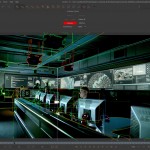
 Now that we’ve confirmed that The Voyage of the Dawn Treader will be converted to 3-D, it’s a good idea to learn exactly what that means. Especially since there is some major controversy surrounding the 3-D release of Clash of the Titans. That film’s 3-D is being widely panned as some of the worst 3-D on the market, and everyone seems to agree that the 2-D version is far superior. Both G-Force and Alice in Wonderland went through the same process, however, and neither had complaints. There’s very good reason for that: time.
Now that we’ve confirmed that The Voyage of the Dawn Treader will be converted to 3-D, it’s a good idea to learn exactly what that means. Especially since there is some major controversy surrounding the 3-D release of Clash of the Titans. That film’s 3-D is being widely panned as some of the worst 3-D on the market, and everyone seems to agree that the 2-D version is far superior. Both G-Force and Alice in Wonderland went through the same process, however, and neither had complaints. There’s very good reason for that: time.
Avatar was filmed with state-of-the-art 3-D cameras, and Alice in Wonderland and G-Force were both converted successfully. The big reason is that both were worked on for months, while Clash of the Titans was converted in about six-to-eight weeks. That’s not near long enough to do a proper conversion.
Here’s a few selections from an interview with In-Three about the 3-D Conversion Process:
Tell me how this process works. Is there a little black box with inputs and outputs and a red button that says “Dimensionalize!”?
Damian Wader: We wish it worked like that!
Matthew DeJohn: It breaks down into three broad artistic phases. One is segmenting the image. You break it up in terms of major layers of depth. You cut out a person [in the scene], maybe somebody else behind him, and then you have the background. The next stage is actually generating the depth for that scene. You model the scene, and our system allows you to create a new perspective, or see the scene from a new perspective once you’ve modeled it out in 3D. And once you are finished with that phase, you’ve revealed parts of the background that weren’t visible in the original perspective, so you have to paint those surfaces, inserting image information where there was none.
[…]
How big is the team for the 2D-to-3D conversion?
MDJ: Generally, for a 100-minute or 120-minute 2D-to-3D conversion, you would need about 300 to 400 artists phasing and out of production over about four to six months.
Are those 400 artists all working on dimensionalization? That’s not at all a trivial process.
MDJ: It’s very serious visual effects work. We have a lot of ways to attack the process that make it easier for us to get people up to speed and control the quality, but it takes a lot of effort to get a very high quality product.
How often do those people have to look at shots in 3D, and how do they do that?
MDJ: Internally, we’re working in 3D the entire time, save creating roto splines and stuff like that. For our depth artists, 50 or 75 percent of the day is spent looking through 3D glasses. We’re submitting stuff for review in 3D internally, because we’ll go through three or four internal reviews before we send to the client.
[…]
And the big question: how much does this cost?
DW: Typically, it’s about $80,000 to $100,000 a minute. That’s generally speaking. As we move forward through development, we can define things that make it more efficient for us and more cost-effective for the production. A lot of animation houses are coming to us. They want to deal with their 2D story, not stereo or CG. Some projects do come to us as legacy pictures, but when we’re involved in the beginning, it’s the best way to take advantage of the process. It will not affect principal photography as a whole, but it will help our efficiency.
MDJ: Because dimensionalization is a post process, you get more artistic control compared to shooting in stereo. We can tailor the depth to match perfectly with the edit. No shots are ever lost if the camera fails. We can go into a stereo show and dimensionalize a flat shot to match the rest of a scene. It provides more flexibility in your depth choices. But you are limited by the realities of the world. If you shot with a long lens, you can only get so much shape out of the character’s face without having the scene way too deep. We can go in and make specific choices and use the available depth budget to its best advantage.
DW: Everything we do is to help the creative get his vision out there. It’s not to take away at all. We want to work with creatives who want to use 3D as a storytelling tool.
[…]
One last question about dimensionalization. Alice in Wonderland got mainly good reviews for its 3D visuals. But as soon as Clash of the Titans started screening for fans, there was a backlash. On the Internet and in some print reviews, a buzz started building that 2D to 3D conversions are no good. [Writing in the Los Angeles Times, Kenneth Turan said, “Consider the possibility that Clash of the Titans is the first film to actually be made worse by being in 3-D.”] How do you feel about that?
MDJ:You bring up Alice as a contrast to that, which is good. I would go back even farther, to G-Force. I don’t think anybody knew that was converted. They all assumed it originated in 3D, because it was really clean. In terms of Clash of the Titans and all of the negative press, we look at that situation and see an eight-to-10-week schedule to do an entire movie, and it sounds completely unrealistic to get a high-quality product in that timeframe. If that’s how it turns out [and 3D conversions get a bad reputation], it will be disappointing for us. We’ve been there at the forefront, talking about our dimensionalization process specifically as an extremely viable and artistically competitive approach to generating 3D. If it doesn’t get there, hopefully that doesn’t paint all conversion houses with the same brush. That’s what we’re afraid of. The audience should be able to trust they’ll get a high-quality product, especially on a huge movie.
If you’d like to read the full interview, click here: In-Three on the Workflow Behind 3D Conversions. I hope that this helps you all to feel more comfortable with the 3-D process, as they have plenty of time to make it look really good. I saw G-Force in 3-D, twice, and it looked good. It’s really fascinating to know exactly how the 3-D conversion process works, and why it didn’t work on Clash of the Titans. On that film, they should have either waited to release it after a proper complete conversion, or they should have merely given it a 2-D release.


Oh joy… another 3D movie. I’ll still see the movie but probably won’t enjoy it as much as i would if it wasn’t 3D. If it does cost that much, its a waste. I’ll be overjoyed when this obsession ends.
Heh, yeah… same here… unless they use 3-D effectively, which I’ve seen done. UP and How to Train Your Dragon were both very effective in 3-D. They ignored that they were in 3-D, and the stories are effective in both 2-D and 3-D. How to Train Your Dragon was particularly spectacular in 3-D at times (I’ve seen it in both).
Dawn Treader will also be released in 2-D, however, which tends to be the trend. Theaters will have the same film on multiple screens to allow for that. So it’s not a lost cause, to see the film in 2-D.
I honestly didn’t know that Clash of the Titans, G-force, or even Up were done in 3D. LOL. And until The Christmas Carol last november, I thought all 3D movies were still those little red and blue glasses! But this article has eased some of my fears, and actually made me a little more excited for the 3D VDT release. It’s just so expensive! (To make it, not the tickets, though they are pretty up there as well.) Ah well, I guess the movie itself matters more than the 3d/2d bits, and as long as both are done well, I’m okay =D.
Clash of the Titans was a terrible movie. 3d or 2d couldn’t help it if the storyline was awful. I felt I wasted my $12.50 for the ticket. I think 2d would have been better, but our theater didn’t have it in 2d only 3d. Voyage is a masterpiece. So it has the story so let’s hope the 3d will be good. Give it a chance.
No 3D for me … not because I’m opposed to it but because I don’t want to pay a ticket price that is 3 times higher than a normal ticket!!
Wow, that’s terrible. At my local theater, it costs 50 cents more to see a movie in 3D on a weekend morning. O_o
That’s not bad at all. Most cost at least a few dollars more.
I may initially see it in 2D just to help with the ticket price, and then see it in 3D once the thearte costs have started to go down. No I don’t want to fork over the extra bucks, but I would love to see the room flooding as they enter the painting, or Eustace flying at me, or possibly some twisting sea-creatures in the mer-kingdom, or the birds pouring accross the sky to consume the remains of the feast at the beginning of the end of the world…
Does anyone know if Walden is having all of VDT converted or just part of it? WB only converted a small part of the last two Harry Potter movies, and I think that made the movies look worse. You saw what you were missing on the rest of the movie. I agree with Lily of Archenland about what scenes of VDT might look good in 3D.
As long as they don’t say “shock and awe” in VDT.
im surprised that Clash of the Titans 3D got so much flack; I went to go watch that movie in 3D and I loved it. So im not really worried about VDT in 3D.
I love 3D…..when it’s done well!!! I have seen 4 films in 3D, A Christmas Carol, Avatar, Alice in Wonderland and Clash of the Titans. The first three were fantastic in 3D, particularly Avatar, but Clash of the Titans 3D was dreadfull. It wasn’t the fact that the 3D effects looked cheap/tacky, it was because they were almost non-existent!!! It looked the same as 2D and was not worth the extra money!(The film was good though!!) I hope they do VDT well and use 3D to create great depth like in Avatar so you actually feel in the film!! and above all, stick to the book!!! I will probably watch it in 3D first, and if the 3D is really bad, will watch it in 2D after. Fingers crossed they do a good job of the 3D!!!
as long as there’s no delays, it’s fine with me
There’s another problem. 3D competition from Tron Legacy, Guliver’s Travels and Yogi Bear.
It wasn’t just Clash of the Titans that caused this controversy about 3D conversions. Recently The Last Airbender had simmilar flack.
I still believe the best 3D movie of 2010 will be Jackass 3D.
Extreme stunts, rowdy overgrown college students and a whole lot of high quality 3D. What could possibly top that?